UAV as a Bridge: Mapping Key Rice Growth Stage with Sentinel-2 Imagery and Novel Vegetation Indices
Abstract
1. Introduction
2. Materials and Methods
2.1. Description of Study Area
2.2. UAV Image Acquisition
2.3. Satellite Image Acquisition and Annotation
2.4. Vegetation Index Construction and Optimization
2.5. Multi-VI Feature Selection
2.6. Model Construction and Validation
3. Results
3.1. Results of Full-Spectrum Modeling
3.2. Results of Vegetation Index Selection
3.3. Results of Multi-Feature Index Selection
4. Discussion
4.1. Integration of UAV Imagery and Satellite Remote Sensing
4.2. Sensitive Bands for Rice Growth Period Classification and Their Physiological Significance
4.3. The Necessity of Multi-Feature Modeling in Complex Spectral Pixel Classification
5. Conclusions
Author Contributions
Funding
Data Availability Statement
Conflicts of Interest
References
- Arthi, B.; Maragatham, N. Effect of Elevated Temperature on Rice Phenology and Yield. Indian J. Sci. Technol. 2013, 6, 5095–5097. [Google Scholar] [CrossRef]
- Bouman, B.A.M.; Humphreys, E.; Tuong, T.P.; Barker, R. Rice and Water. In Advances in Agronomy; Sparks, D.L., Ed.; Academic Press: Cambridge, MA, USA, 2007; Volume 92, pp. 187–237. [Google Scholar]
- Hou, W.; Shen, J.; Xu, W.; Khan, M.R.; Wang, Y.; Zhou, X.; Gao, Q.; Murtaza, B.; Zhang, Z. Recommended Nitrogen Rates and the Verification of Effects Based on Leaf SPAD Readings of Rice. PeerJ 2021, 9, e12107. [Google Scholar] [CrossRef]
- Xu, M.; Xu, J.; Xu, M.; Xu, Y. Spatiotemporal variation characteristics and forecast model construction of high temperature heat damage intensity in rice. Trans. Chin. Soc. Agric. Eng. Trans. CSAE 2024, 40, 97–106. [Google Scholar] [CrossRef]
- Sharma, K.R.; Raju, S.V.S.; Singh, K.; Babu, S.R. Effect of Crop Growth Stages on the Field Population of Rice Hoppers. Indian J. Entomol. 2023, 85, 701–703. [Google Scholar] [CrossRef]
- Duan, B.; Fang, S.; Zhu, R.; Wu, X.; Wang, S.; Gong, Y.; Peng, Y. Remote Estimation of Rice Yield With Unmanned Aerial Vehicle (UAV) Data and Spectral Mixture Analysis. Front. Plant Sci. 2019, 10, 204. [Google Scholar] [CrossRef]
- Li, S.; Xiao, J.; Ni, P.; Zhang, J.; Wang, H.; Wang, J. Monitoring Paddy Rice Phenology Using Time Series MODIS Data over Jiangxi Province, China. Int. J. Agric. Biol. Eng. 2014, 7, 28–36. [Google Scholar] [CrossRef]
- Singh, R.P.; Oza, S.R.; Pandya, M.R. Observing Long-Term Changes in Rice Phenology Using NOAA–AVHRR and DMSP–SSM/I Satellite Sensor Measurements in Punjab, India. Curr. Sci. 2006, 91, 1217–1221. [Google Scholar]
- Ma, Y.; Jiang, Q.; Wu, X.; Zhu, R.; Gong, Y.; Peng, Y.; Duan, B.; Fang, S. Monitoring Hybrid Rice Phenology at Initial Heading Stage Based on Low-Altitude Remote Sensing Data. Remote Sens. 2021, 13, 86. [Google Scholar] [CrossRef]
- Xie, Z.; Zhang, C.; Feng, S.; Zhang, F.; Cai, H.; Tang, M.; Kong, J. Reviews of methods for vegetation phenology monitoring from remote sensing data. Remote Sens. Technol. Appl. 2023, 38, 1–14. [Google Scholar]
- Moeini Rad, A.; Ashourloo, D.; Salehi Shahrabi, H.; Nematollahi, H. Developing an Automatic Phenology-Based Algorithm for Rice Detection Using Sentinel-2 Time-Series Data. IEEE J. Sel. Top. Appl. Earth Obs. Remote Sens. 2019, 12, 1471–1481. [Google Scholar] [CrossRef]
- Liao, C.; Wang, J.; Shan, B.; Shang, J.; Dong, T.; He, Y. Near Real-Time Detection and Forecasting of Within-Field Phenology of Winter Wheat and Corn Using Sentinel-2 Time-Series Data. ISPRS J. Photogramm. Remote Sens. 2023, 196, 105–119. [Google Scholar] [CrossRef]
- Bendig, J.; Yu, K.; Aasen, H.; Bolten, A.; Bennertz, S.; Broscheit, J.; Gnyp, M.L.; Bareth, G. Combining UAV-Based Plant Height from Crop Surface Models, Visible, and near Infrared Vegetation Indices for Biomass Monitoring in Barley. Int. J. Appl. Earth Obs. Geoinf. 2015, 39, 79–87. [Google Scholar] [CrossRef]
- Astridevi; Zainuddin, Z.; Paundu, A.W. Rice Growth Phase Detection in Rice Field Plots Using Drone Imagery. In Proceedings of the 2024 19th International Joint Symposium on Artificial Intelligence and Natural Language Processing (iSAI-NLP), Chonburi, Thailand, 14 November 2024; pp. 1–6. [Google Scholar]
- Qiu, Z.; Liu, H.; Wang, L.; Shao, S.; Chen, C.; Liu, Z.; Liang, S.; Wang, C.; Cao, B. Accurate Prediction of 327 Rice Variety Growth Period Based on Unmanned Aerial Vehicle Multispectral Remote Sensing. Drones 2024, 8, 665. [Google Scholar] [CrossRef]
- Lu, X.; Zhou, J.; Yang, R.; Yan, Z.; Lin, Y.; Jiao, J.; Liu, F. Automated Rice Phenology Stage Mapping Using UAV Images and Deep Learning. Drones 2023, 7, 83. [Google Scholar] [CrossRef]
- Zhu, W.; Rezaei, E.E.; Nouri, H.; Sun, Z.; Li, J.; Yu, D.; Siebert, S. UAV-Based Indicators of Crop Growth Are Robust for Distinct Water and Nutrient Management but Vary between Crop Development Phases. Field Crops Res. 2022, 284, 108582. [Google Scholar] [CrossRef]
- Zhang, D.; Qi, H.; Guo, X.; Sun, H.; Min, J.; Li, S.; Hou, L.; Lv, L. Integration of UAV Multispectral Remote Sensing and Random Forest for Full-Growth Stage Monitoring of Wheat Dynamics. Agriculture 2025, 15, 353. [Google Scholar] [CrossRef]
- Du, M.; Noguchi, N. Multi-Temporal Monitoring of Wheat Growth through Correlation Analysis of Satellite Images, Unmanned Aerial Vehicle Images with Ground Variable. IFAC-PapersOnLine 2016, 49, 5–9. [Google Scholar] [CrossRef]
- Kiang, R.K. Textural-Contextual Labeling and Metadata Generation for Remote Sensing Applications. In Applications and Science of Computational Intelligence II; SPIE: Bellingham, WA, USA, 1999; Volume 3722, pp. 243–248. [Google Scholar]
- Ma, H.; Zhang, J.; Huang, W.; Ruan, C.; Chen, D.; Zhang, H.; Zhou, X.; Gui, Z. Monitoring Yellow Rust Progression during Spring Critical Wheat Growth Periods Using Multi-Temporal Sentinel-2 Imagery. Pest. Manag. Sci. 2024, 80, 6082–6095. [Google Scholar] [CrossRef]
- Huang, L.; Jiang, J.; Huang, W.; Ye, H.; Zhao, J.; Ma, H.; Ruan, C. Wheat yellow rust monitoring method based on Sentinel-2 image and BPNN model. Trans. Chin. Soc. Agric. Eng. 2019, 35, 178–185. [Google Scholar] [CrossRef]
- Nowakowski, M.; Dudek, E.; Rosiński, A. The Influence of Varying Atmospheric and Space Weather Conditions on the Accuracy of Position Determination. Sensors 2023, 23, 2814. [Google Scholar] [CrossRef]
- Xu, B.; Li, J.; Liu, Q.; Xin, X.; Zeng, Y.; Yin, G. Review of methods for evaluating representativeness of ground station observations. J. Remote Sens. 2015, 19, 703–718. [Google Scholar] [CrossRef]
- Islam, M.K.; Simic Milas, A.; Abeysinghe, T.; Tian, Q. Integrating UAV-Derived Information and WorldView-3 Imagery for Mapping Wetland Plants in the Old Woman Creek Estuary, USA. Remote Sens. 2023, 15, 1090. [Google Scholar] [CrossRef]
- Wu, Y.; Wang, Y.; Deng, J.; Li, Y.; Zhang, R. Bridging Field Investigation and Sentinel 2 Satellite Image with UAV Remote Sensing for Yield Inversion of Chinese Pepper. In Advances in Guidance, Navigation and Control; Yan, L., Duan, H., Deng, Y., Eds.; Springer Nature: Singapore, 2025; pp. 543–556. [Google Scholar]
- Wang, M.; Wang, J.; Chen, L.; Du, Z. Mapping Paddy Rice and Rice Phenology with Sentinel-1 SAR Time Series Using a Unified Dynamic Programming Framework. Open Geosci. 2022, 14, 414–428. [Google Scholar] [CrossRef]
- Supriatna; Rokhmatuloh; Wibowo, A.; Shidiq, I.P.A.; Pratama, G.P.; Gandharum, L. Spatio-temporal analysis of rice field phenology using Sentinel-1 image in Karawang Regency West Java, Indonesia. Int. J. GEOMATE 2019, 17, 101–106. [Google Scholar] [CrossRef]
- Badrul Hisham, N.H.; Hashim, N.; Saraf, N.M.; Talib, N. Monitoring of Rice Growth Phases Using Multi-Temporal Sentinel-2 Satellite Image. IOP Conf. Ser. Earth Environ. Sci. 2022, 1051, 012021. [Google Scholar] [CrossRef]
- Deng, J.; Wang, R.; Yang, L.; Lv, X.; Yang, Z.; Zhang, K.; Zhou, C.; Pengju, L.; Wang, Z.; Abdullah, A.; et al. Quantitative Estimation of Wheat Stripe Rust Disease Index Using Unmanned Aerial Vehicle Hyperspectral Imagery and Innovative Vegetation Indices. IEEE Trans. Geosci. Remote Sens. 2023, 61, 4406111. [Google Scholar] [CrossRef]
- Zhao, Z.; Anand, R.; Wang, M. Maximum Relevance and Minimum Redundancy Feature Selection Methods for a Marketing Machine Learning Platform. In Proceedings of the 2019 IEEE International Conference on Data Science and Advanced Analytics (DSAA), Washington, DC, USA, 5–8 October 2019; pp. 442–452. [Google Scholar]
- Cunningham, P.; Delany, S.J. K-Nearest Neighbour Classifiers: 2nd Edition (with Python Examples). ACM Comput. Surv. 2022, 54, 128. [Google Scholar] [CrossRef]
- Hearst, M.A.; Dumais, S.T.; Osuna, E.; Platt, J.; Scholkopf, B. Support Vector Machines. IEEE Intell. Syst. Their Appl. 1998, 13, 18–28. [Google Scholar] [CrossRef]
- Tolstikhin, I.; Houlsby, N.; Kolesnikov, A.; Beyer, L.; Zhai, X.; Unterthiner, T.; Yung, J.; Steiner, A.; Keysers, D.; Uszkoreit, J.; et al. MLP-Mixer: An All-MLP Architecture for Vision. arXiv 2021, arXiv:2105.01601. [Google Scholar]
- Chen, T.; Guestrin, C. XGBoost: A Scalable Tree Boosting System. In Proceedings of the 22nd ACM SIGKDD International Conference on Knowledge Discovery and Data Mining, San Francisco, CA, USA, 13 August 2016; pp. 785–794. [Google Scholar]
- Breiman, L. Random Forests. Mach. Learn. 2001, 45, 5–32. [Google Scholar] [CrossRef]
- Powers, D.M.W. Evaluation: From Precision, Recall and F-Measure to ROC, Informedness, Markedness and Correlation. arXiv 2020, arXiv:2010.16061. [Google Scholar]
- Liu, W.; Xiang, Y.; Zheng, L.; Tong, Q.; Wu, C. Relationships between Rice LAl, CH.D and Hyperspectra Data. J. Remote Sens. 2000, 4, 279–283. [Google Scholar]
- Zhang, J.; Xu, Y.; Yao, F.; Wang, P.; Guo, W.; Li, L.; Yang, L. Advances in estimation methods of vegetation water content based on optical remote sensing techniques. Sci. China Technol. Sci. 2010, 53, 1159–1167. [Google Scholar] [CrossRef]

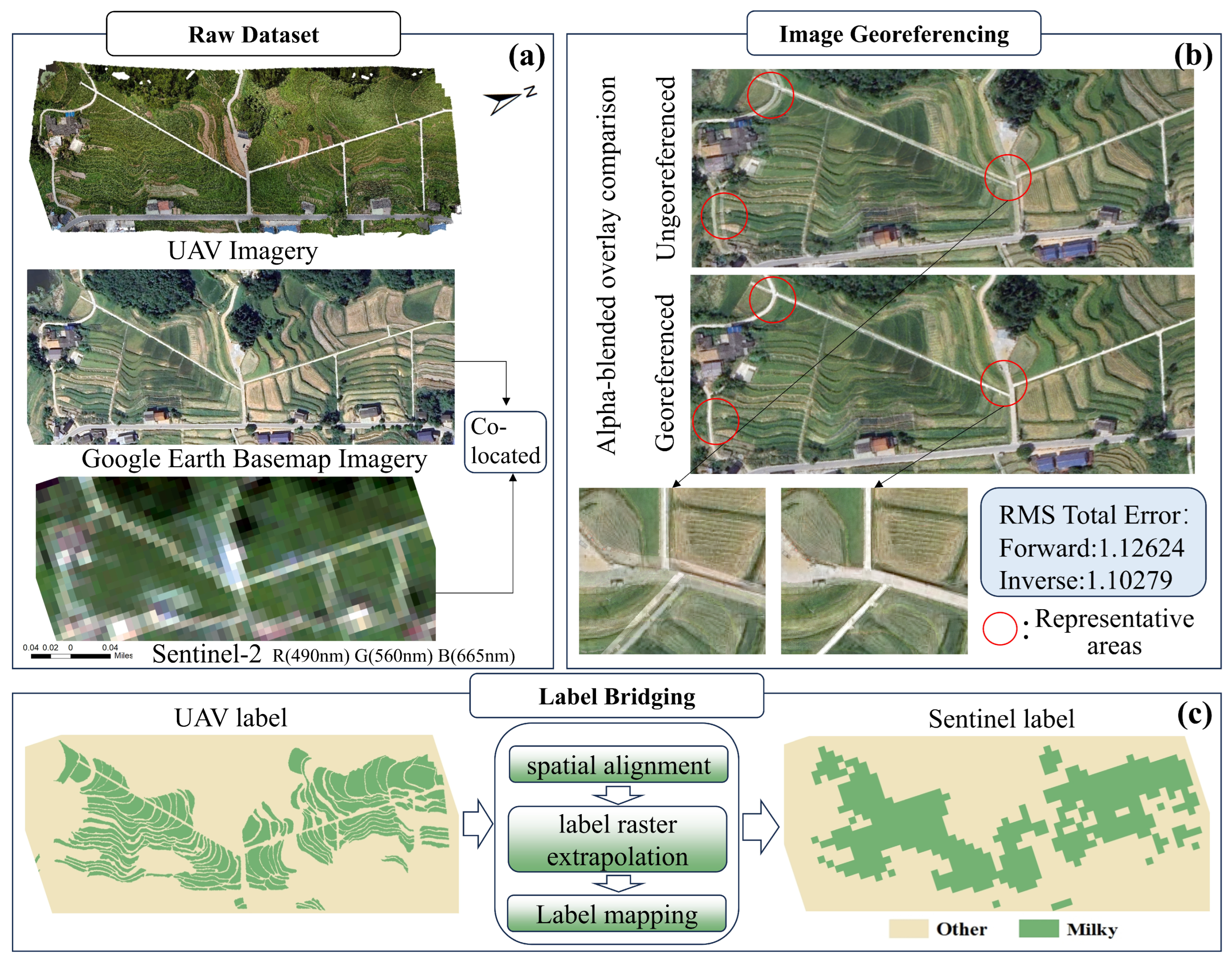


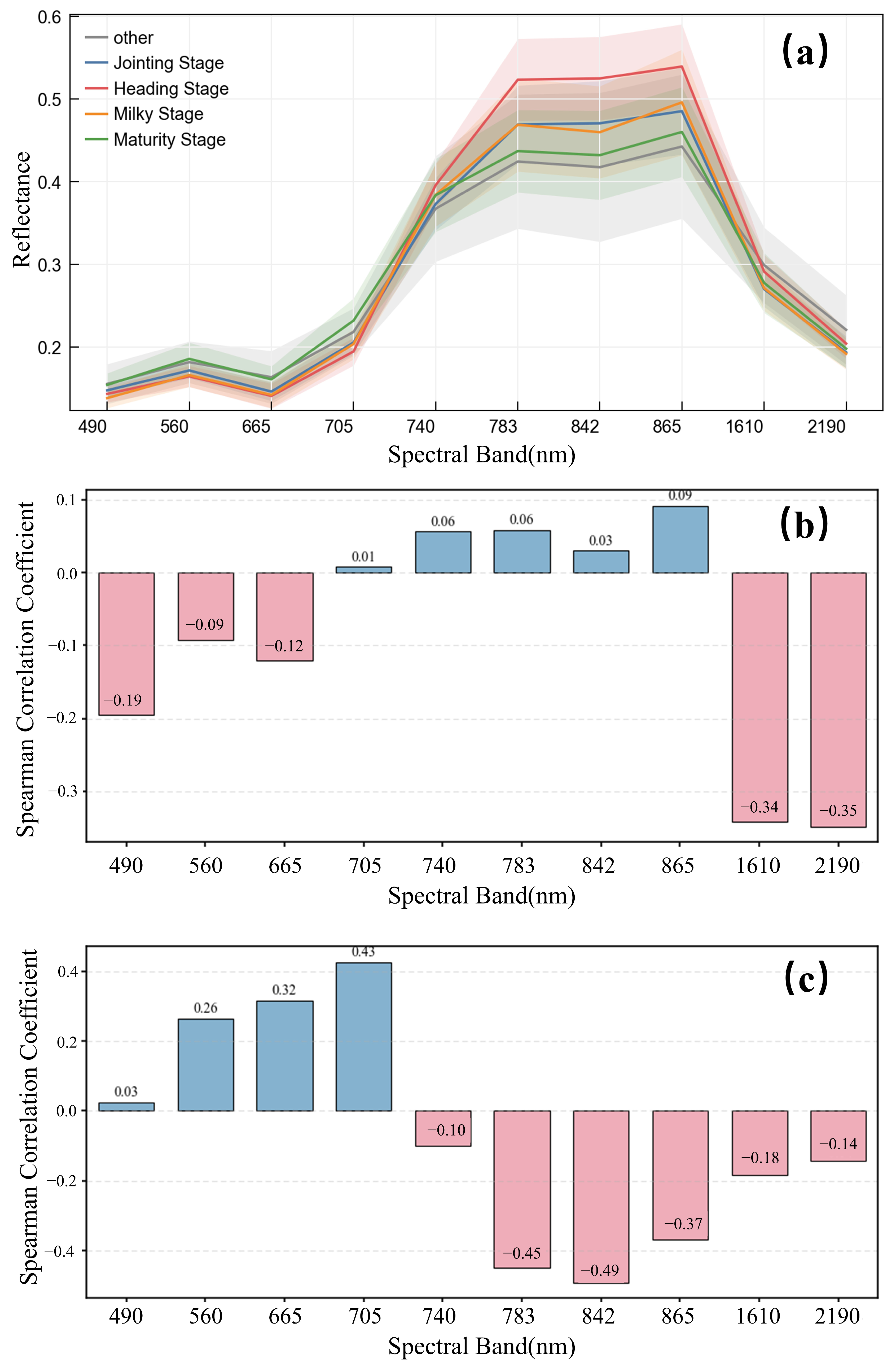

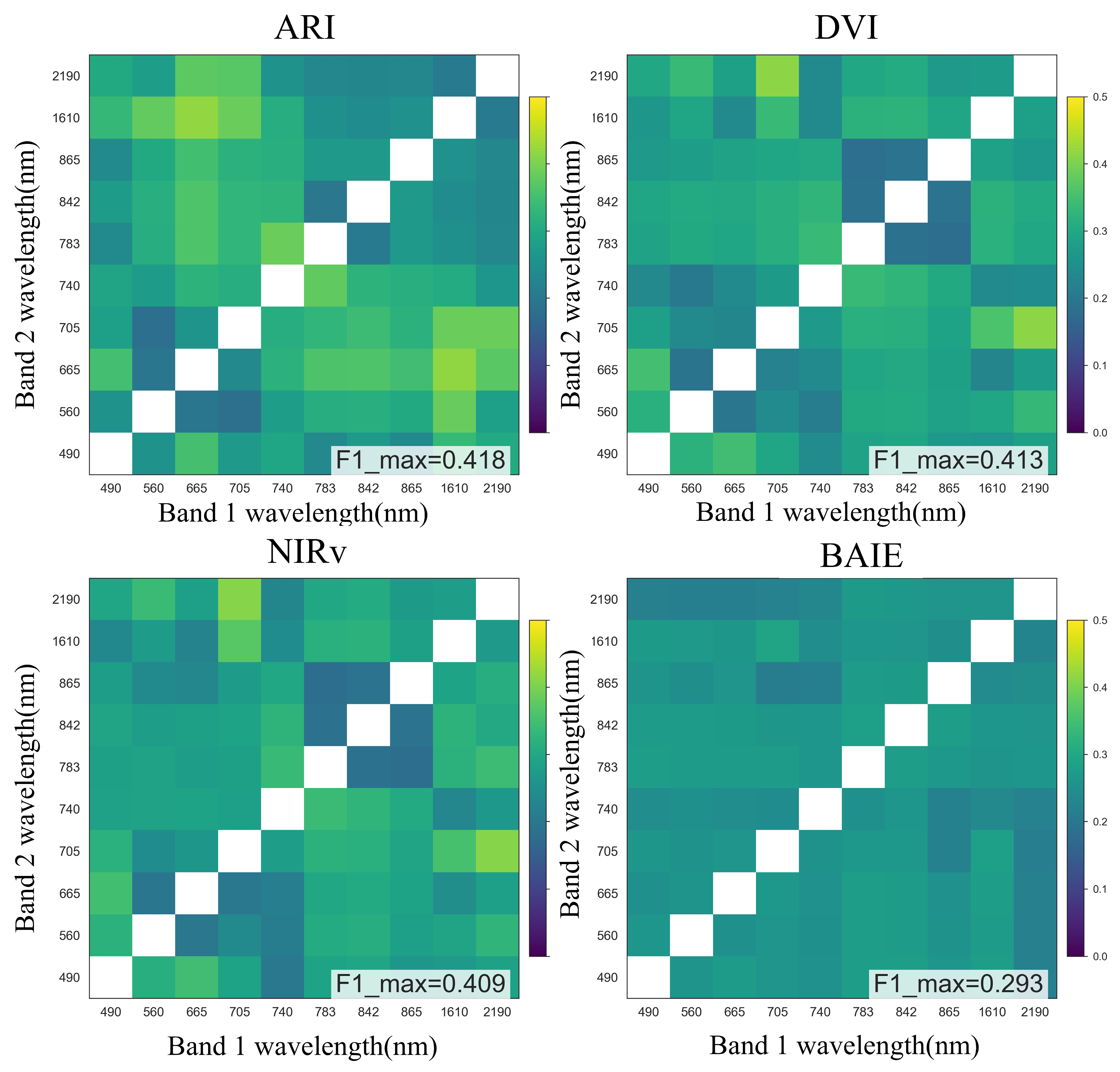
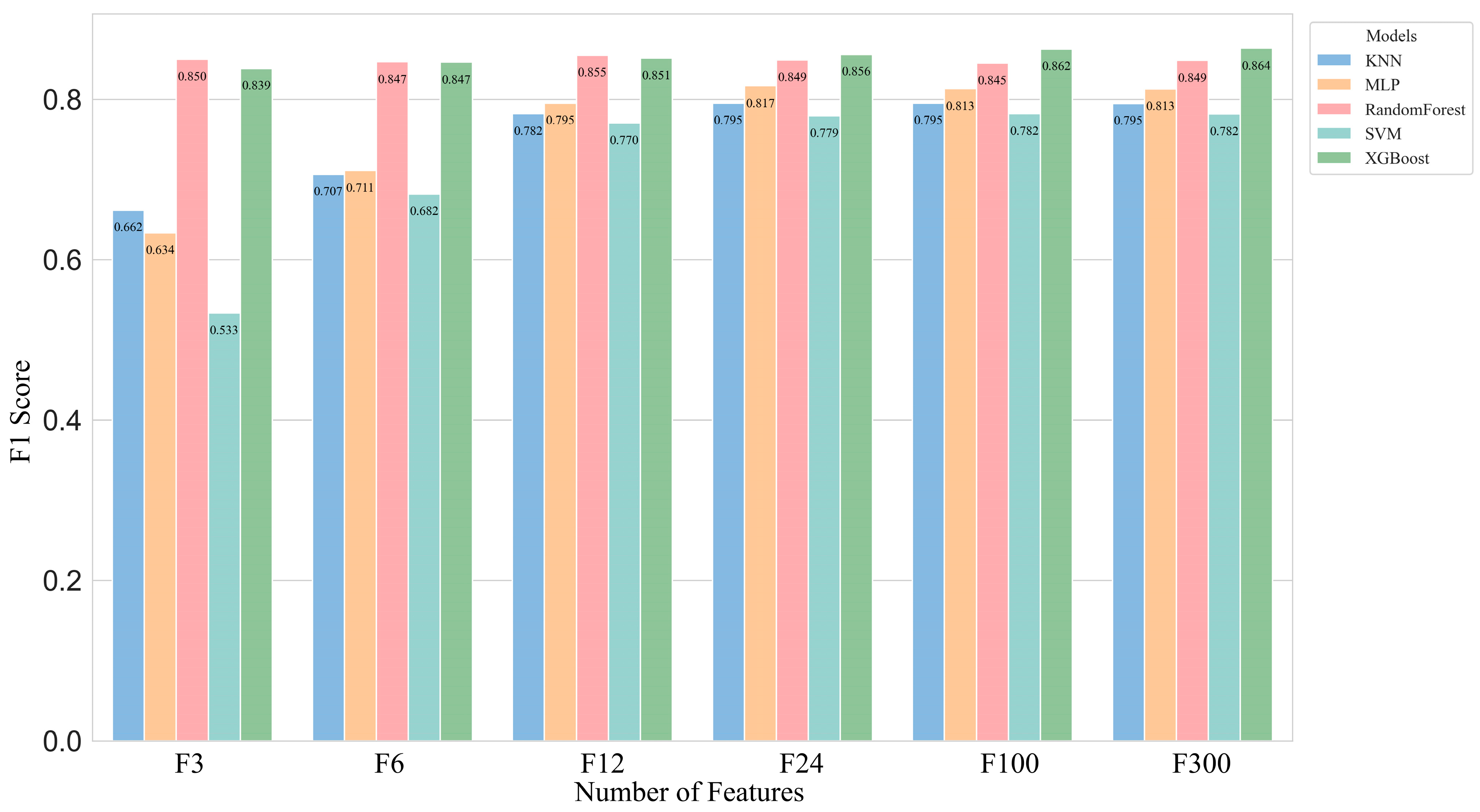
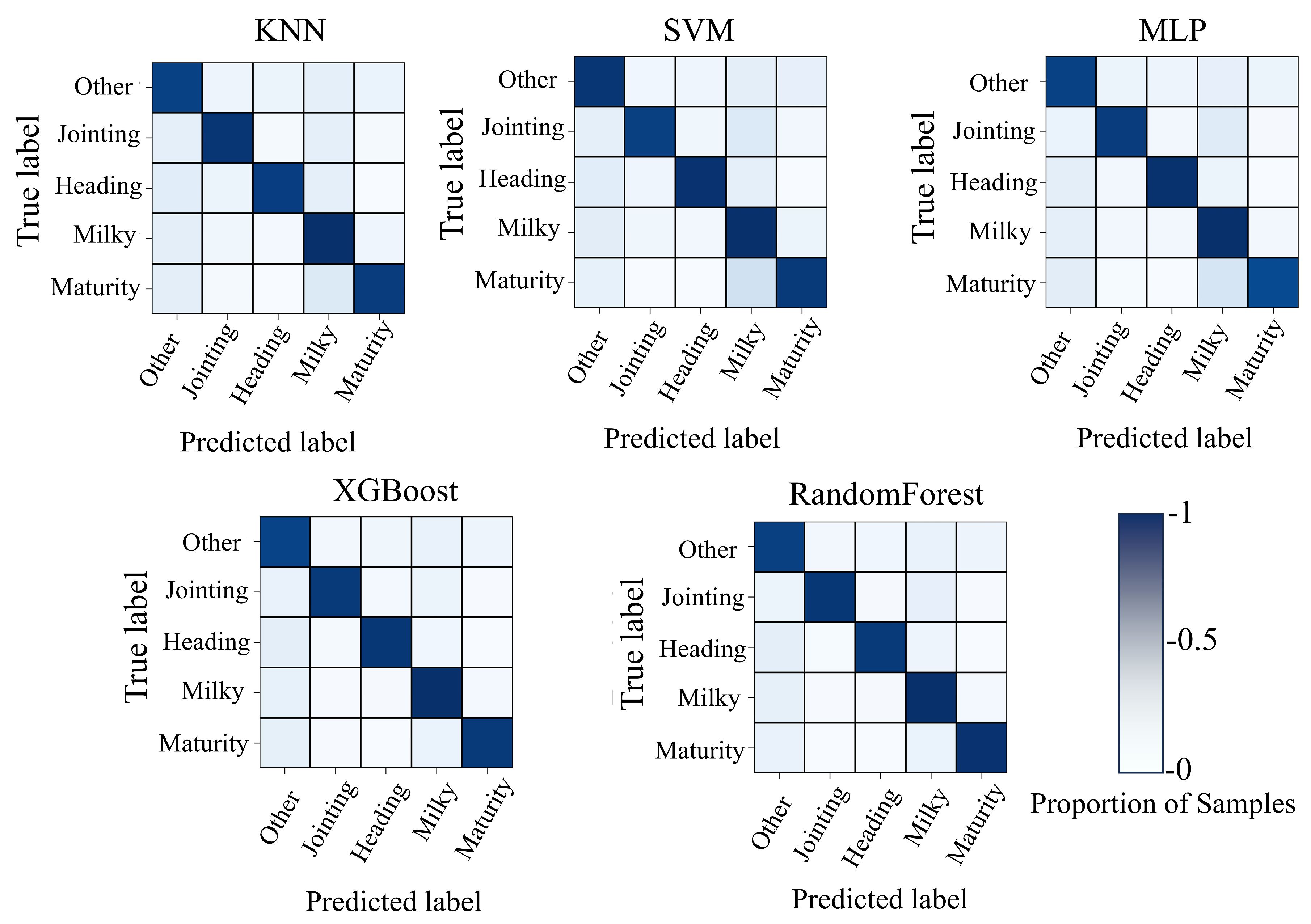
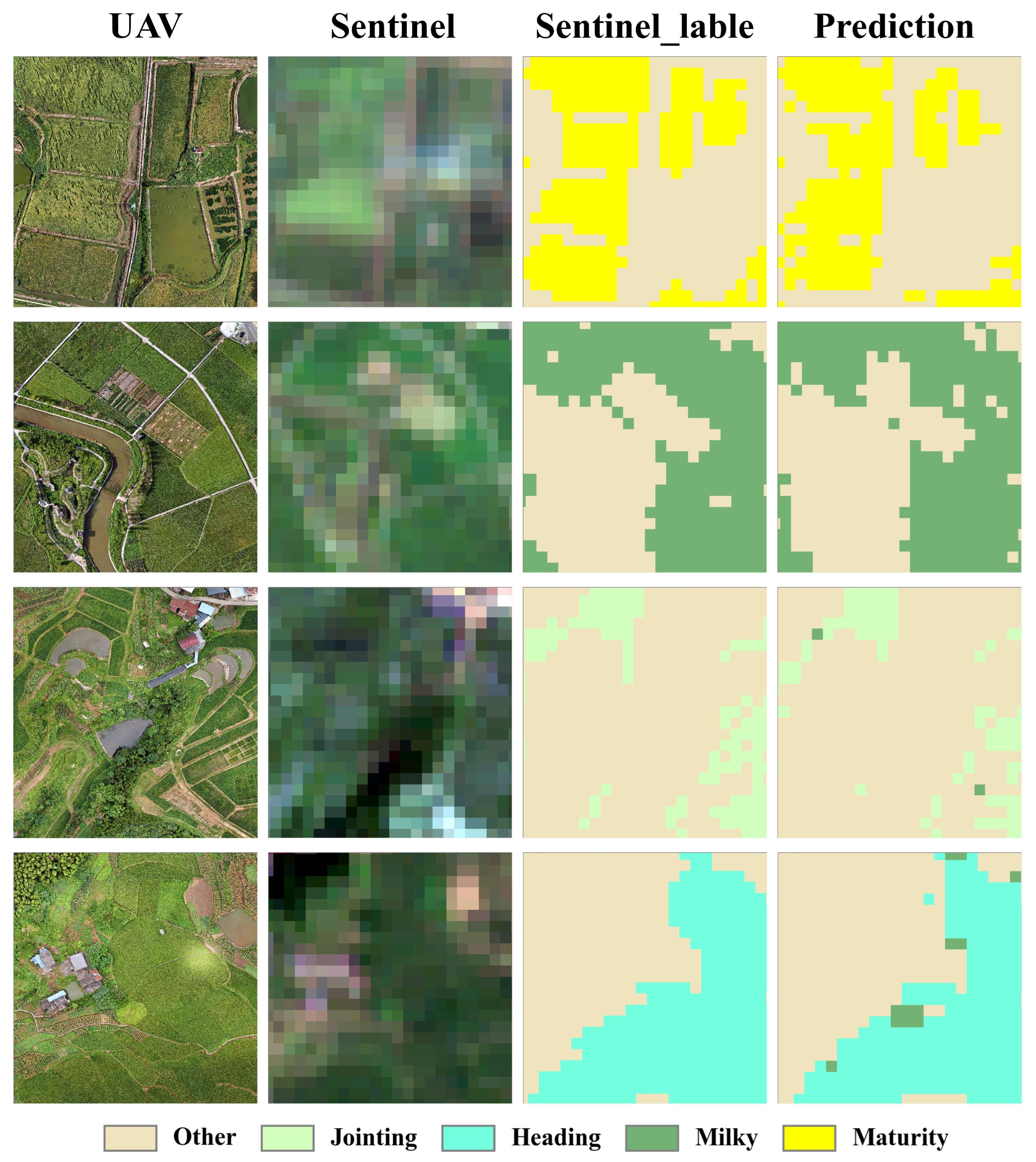
| Imagery | Location | Growth Stage | Cell Size (cm) | Resolution (Pixel) |
|---|---|---|---|---|
| DJI_202307181803_002 | Yongchuan Laishu | Heading | (0.2, 0.2) | 25,733 × 20,569 |
| DJI_202307191526_001 | Kaizhou | Heading | (0.2, 0.2) | 19,576 × 24,503 |
| DJI_202307200949_002 | Kaizhou Dade | Jointing | (0.2, 0.2) | 22,160 × 22,869 |
| DJI_202307201727_007 | Nanchuan Nongji | Jointing | (0.2, 0.2) | 24,432 × 31,413 |
| DJI_202307201851_001 | Nanchuan Fushou | Jointing | (0.2, 0.2) | 26,666 × 20,154 |
| DJI_202308131333_013 | Nanchuan Fushou | Milky | (0.2, 0.2) | 26,955 × 19,198 |
| DJI_202308131629_014 | Nanchuan Nongji | Milky | (0.2, 0.2) | 24,769 × 28,047 |
| DJI_202308140904_015 | Yongchuan Laishu | Maturity | (0.2, 0.2) | 24,719 × 22,190 |
| DJI_202308141250_016 | Tongnan Chongcan | Milky | (0.2, 0.2) | 23,152 × 18,702 |
| DJI_202308141525_017 | Tongnan Zitan | Maturity | (0.2, 0.2) | 23,152 × 18,702 |
| Index Acronym | Complete Name | Calculation Method | |
|---|---|---|---|
| 2Band | NDVI | Normalized Difference Vegetation Index | (b1 − b2)/(b1 + b2) |
| TDVI | Transformed Difference Vegetation Index | 1.5 × ((b1 − b2)/((b12 + b22 + 0.5)0.5)) | |
| NIRv | Near-Infrared Reflectance of Vegetation | ((b1 − b2)/(b1 + b2)) × b1 | |
| MSI | Moisture Stress Index | b2/b1 | |
| MGRVI | Modified Green Red Vegetation Index | (b12 − b22)/(b12 + b22) | |
| IPVI | Infrared Percentage Vegetation Index | b2/(b2 + b1) | |
| EVI2 | Two-Band Enhanced Vegetation Index | 2.5 × (b2 − b1)/(b2 + 2.4 × b1 + 6) | |
| DVI | Difference Vegetation Index | b2 − b1 | |
| CIG | Chlorophyll Index Green | (b2/b1) − 1.0 | |
| CSI | Char Soil Index | b1/b2 | |
| BAI | Burned Area Index | 1.0/((0.1 − b1)2 + (0.06 − b2)2) | |
| ARI | Anthocyanin Reflectance Index | (1/b1) − (1/b2) | |
| 3Band | ARI2 | Anthocyanin Reflectance Index 2 | b3 × ((1/b1) − (1/b2)) |
| ARVI | Atmospherically Resistant Vegetation Index | (b3 − (b2 − 2.5 × (b2 − b1)))/(b3 + (b2 − 2.5 × (b2 − b1))) | |
| SWI | Snow Water Index | (b1 × (b2 − b3))/((b1 + b2) × (b2 + b3)) | |
| EBBI | Enhanced Built-Up and Bareness Index | (b2 − b1)/(10.0 × ((b3 + b2) 0.5)) | |
| EVI | Enhanced Vegetation Index | 2.5 × (b3 − b2)/(b3 + 6 × b2 − 7.5 × b1 + 1) | |
| GBNDVI | Green-Blue Normalized Difference Vegetation Index | (b3 − (b2 + b1))/(b3 + (b2 + b1)) | |
| GLI | Green Leaf Index | (2.0 × b3 − b2 − b1)/(2.0 × b3 + b2 + b1) | |
| MBI | Modified Bare Soil Index | ((b2 − b3 − b1)/(b2 + b3 + b1)) + 0.5 | |
| PSRI | Plant Senescing Reflectance Index | (b2 − b1)/b3 | |
| BaI | Bareness Index | b1 + b3 − b2 | |
| 4Band | BLFEI | Built-Up Land Features Extraction Index | (((b1 + b2 + b4)/3.0) − b3)/(((b1 + b2 + b4)/3.0) + b3) |
| BI | Bare Soil Index | ((b4 + b2) − (b3 + b1))/((b4 + b2) + (b3 + b1)) | |
| DBI | Dry Built-Up Index | ((b1 − b4)/(b1 + b4)) − ((b3 − b2)/(b3 + b2)) | |
| DBSI | Dry Bareness Index | ((b4 − b1)/(b1 + b4)) − ((b3 − b2)/(b3 + b2)) | |
| EMBI | Enhanced Modified Bare Soil Index | ((((b3 − b4 − b2)/(b3 + b4 + b2)) + 0.5) − ((b1 − b3)/(b1 + b3)) − 0.5)/((((b3 − b4 − b2)/(b3 + b4 + b2)) + 0.5) + ((b1 − b3)/(b1 + b3)) + 1.5) | |
| FCVI | Fluorescence Correction Vegetation Index | b4 − ((b1 + b2 + b3)/3.0) | |
| GARI | Green Atmospherically Resistant Vegetation Index | (b4 − (b1 − (b2 − b3)))/(b4 − (b1 + (b2 − b3))) | |
| WRI | Water Ratio Index | (b1 + b2)/(b3 + b4) |
| Class | KNN | SVM | MLP | XGBoost | Random Forest | |
|---|---|---|---|---|---|---|
| Precision | Other | 0.800 ± 0.00569 | 0.794 ± 0.01136 | 0.809 ± 0.01455 | 0.814 ± 0.01427 | 0.797 ± 0.01594 |
| Heading | 0.755 ± 0.02470 | 0.805 ± 0.01836 | 0.805 ± 0.01147 | 0.839 ± 0.01227 | 0.810 ± 0.00585 | |
| Jointing | 0.849 ± 0.01835 | 0.862 ± 0.01298 | 0.838 ± 0.00387 | 0.881 ± 0.01347 | 0.904 ± 0.01692 | |
| Milky | 0.832 ± 0.00676 | 0.831 ± 0.00172 | 0.834 ± 0.01034 | 0.863 ± 0.00685 | 0.814 ± 0.00441 | |
| Maturity | 0.752 ± 0.01083 | 0.719 ± 0.00772 | 0.735 ± 0.02539 | 0.803 ± 0.01100 | 0.788 ± 0.01262 | |
| Mean | 0.798 ± 0.00758 | 0.802 ± 0.00773 | 0.804 ± 0.00666 | 0.840 ± 0.00498 | 0.823 ± 0.00526 | |
| Recall | Other | 0.770 ± 0.00054 | 0.818 ± 0.00834 | 0.809 ± 0.01684 | 0.819 ± 0.00743 | 0.807 ± 0.00744 |
| Heading | 0.823 ± 0.01268 | 0.734 ± 0.01803 | 0.759 ± 0.02439 | 0.839 ± 0.01398 | 0.800 ± 0.00228 | |
| Jointing | 0.790 ± 0.01648 | 0.819 ± 0.01067 | 0.828 ± 0.01602 | 0.834 ± 0.00964 | 0.787 ± 0.01502 | |
| Milky | 0.833 ± 0.01674 | 0.837 ± 0.01602 | 0.854 ± 0.02557 | 0.870 ± 0.01308 | 0.869 ± 0.01448 | |
| Maturity | 0.829 ± 0.00798 | 0.759 ± 0.01916 | 0.743 ± 0.01596 | 0.832 ± 0.00664 | 0.780 ± 0.02028 | |
| Mean | 0.809 ± 0.00659 | 0.793 ± 0.00757 | 0.798 ± 0.00605 | 0.839 ± 0.00361 | 0.809 ± 0.00461 | |
| F1 score | Other | 0.785 ± 0.00300 | 0.806 ± 0.00863 | 0.809 ± 0.00819 | 0.816 ± 0.01076 | 0.802 ± 0.01154 |
| Heading | 0.787 ± 0.01817 | 0.768 ± 0.01816 | 0.781 ± 0.01836 | 0.839 ± 0.01312 | 0.805 ± 0.00398 | |
| Jointing | 0.819 ± 0.01416 | 0.840 ± 0.00983 | 0.833 ± 0.00794 | 0.857 ± 0.00338 | 0.841 ± 0.00397 | |
| Milky | 0.832 ± 0.01175 | 0.834 ± 0.00852 | 0.843 ± 0.00794 | 0.866 ± 0.00534 | 0.841 ± 0.00450 | |
| Maturity | 0.789 ± 0.00946 | 0.738 ± 0.00518 | 0.738 ± 0.00556 | 0.817 ± 0.00641 | 0.784 ± 0.01237 | |
| Mean | 0.802 ± 0.00707 | 0.797 ± 0.00758 | 0.801 ± 0.00643 | 0.839 ± 0.00423 | 0.815 ± 0.00430 |
| Feature Selection of mRMR Algorithm | |
|---|---|
| 3 | DBI (783 nm,2190 nm,842 nm,1610 nm) |
| EVI (783 nm,2190 nm,842 nm) | |
| BAIe (1610 nm,842 nm) | |
| 6 | TDVI (842 nm,1610 nm) |
| EVI (1610 nm,2190 nm,842 nm) | |
| PSRI (1610 nm,842 nm,783 nm) | |
| 12 | MSI (665 nm,490 nm) |
| ARI (783 nm,1610 nm) | |
| GBNDVI (2190 nm,842 nm,842 nm) | |
| BaI (842 nm,1610 nm,842 nm) | |
| NIRv (783 nm,2190 nm) | |
| BaI (842 nm,783 nm,1610 nm) | |
| 24 | FCVI (842 nm,1610 nm,783 nm,1610 nm) |
| NIRv (842 nm,1610 nm) | |
| SWI (842 nm,865 nm,2190 nm) | |
| EMBI (783 nm,2190 nm,842 nm,490 nm) | |
| GBNDVI (2190 nm,490 nm,842 nm) | |
| MGRVI (1610 nm,783 nm) | |
| DBI (1610 nm,842 nm,2190 nm,842 nm) | |
| CIG (842 nm,842 nm) | |
| BaI (842 nm,2190 nm,665 nm) | |
| PSRI (842 nm,1610 nm,865 nm) | |
| GBNDVI (490 nm,1610 nm,842 nm) | |
| NIRv (665 nm,490 nm) |
| Class | KNN | SVM | MLP | XGBoost | RandomForest | |
|---|---|---|---|---|---|---|
| Precision | Other | 0.801 ± 0.006 | 0.814 ± 0.005 | 0.830 ± 0.011 | 0.831 ± 0.006 | 0.841 ± 0.003 |
| Heading | 0.729 ± 0.022 | 0.762 ± 0.022 | 0.780 ± 0.005 | 0.870 ± 0.017 | 0.873 ± 0.025 | |
| Jointing | 0.837 ± 0.021 | 0.851 ± 0.029 | 0.824 ± 0.025 | 0.888 ± 0.010 | 0.891 ± 0.018 | |
| Milky | 0.794 ± 0.010 | 0.754 ± 0.006 | 0.792 ± 0.009 | 0.851 ± 0.014 | 0.843 ± 0.008 | |
| Maturity | 0.737 ± 0.023 | 0.693 ± 0.029 | 0.746 ± 0.029 | 0.828 ± 0.013 | 0.838 ± 0.006 | |
| All | 0.780 ± 0.045 | 0.775 ± 0.059 | 0.794 ± 0.036 | 0.854 ± 0.026 | 0.857 ± 0.025 | |
| Recall | Other | 0.770 ± 0.006 | 0.779 ± 0.017 | 0.779 ± 0.022 | 0.815 ± 0.015 | 0.812 ± 0.014 |
| Heading | 0.773 ± 0.033 | 0.704 ± 0.046 | 0.774 ± 0.030 | 0.827 ± 0.031 | 0.828 ± 0.029 | |
| Jointing | 0.784 ± 0.006 | 0.779 ± 0.015 | 0.811 ± 0.018 | 0.860 ± 0.015 | 0.853 ± 0.009 | |
| Milky | 0.815 ± 0.015 | 0.818 ± 0.018 | 0.838 ± 0.019 | 0.895 ± 0.011 | 0.899 ± 0.013 | |
| Maturity | 0.787 ± 0.022 | 0.764 ± 0.009 | 0.787 ± 0.016 | 0.850 ± 0.007 | 0.876 ± 0.011 | |
| All | 0.786 ± 0.023 | 0.769 ± 0.044 | 0.798 ± 0.030 | 0.849 ± 0.033 | 0.854 ± 0.036 | |
| F1 score | Other | 0.785 ± 0.006 | 0.796 ± 0.011 | 0.804 ± 0.016 | 0.823 ± 0.011 | 0.827 ± 0.006 |
| Heading | 0.750 ± 0.027 | 0.732 ± 0.035 | 0.777 ± 0.014 | 0.848 ± 0.022 | 0.850 ± 0.022 | |
| Jointing | 0.809 ± 0.007 | 0.813 ± 0.010 | 0.817 ± 0.006 | 0.874 ± 0.003 | 0.872 ± 0.006 | |
| Milky | 0.804 ± 0.006 | 0.785 ± 0.005 | 0.814 ± 0.004 | 0.873 ± 0.004 | 0.870 ± 0.003 | |
| Maturity | 0.761 ± 0.013 | 0.726 ± 0.018 | 0.765 ± 0.010 | 0.839 ± 0.009 | 0.857 ± 0.006 | |
| All | 0.782 ± 0.027 | 0.770 ± 0.040 | 0.795 ± 0.023 | 0.851 ± 0.023 | 0.855 ± 0.019 |
| Band1 | Band2 | Band3 | Band4 | F1_Average | F1_Max_Index | |
|---|---|---|---|---|---|---|
| 2band | 705 nm | 2190 nm | 0.387 | 0.412 | ||
| 3band | 2190 nm | 705 nm | 1610 nm | 0.371 | 0.417 | |
| 4band | 2190 nm | 842 nm | 705 nm | 560 nm | 0.370 | 0.456 |
Disclaimer/Publisher’s Note: The statements, opinions and data contained in all publications are solely those of the individual author(s) and contributor(s) and not of MDPI and/or the editor(s). MDPI and/or the editor(s) disclaim responsibility for any injury to people or property resulting from any ideas, methods, instructions or products referred to in the content. |
© 2025 by the authors. Licensee MDPI, Basel, Switzerland. This article is an open access article distributed under the terms and conditions of the Creative Commons Attribution (CC BY) license (https://creativecommons.org/licenses/by/4.0/).
Share and Cite
Zhang, J.; Zhang, R.; Meng, Q.; Chen, Y.; Deng, J.; Chen, B. UAV as a Bridge: Mapping Key Rice Growth Stage with Sentinel-2 Imagery and Novel Vegetation Indices. Remote Sens. 2025, 17, 2180. https://doi.org/10.3390/rs17132180
Zhang J, Zhang R, Meng Q, Chen Y, Deng J, Chen B. UAV as a Bridge: Mapping Key Rice Growth Stage with Sentinel-2 Imagery and Novel Vegetation Indices. Remote Sensing. 2025; 17(13):2180. https://doi.org/10.3390/rs17132180
Chicago/Turabian StyleZhang, Jianping, Rundong Zhang, Qi Meng, Yanying Chen, Jie Deng, and Bingtai Chen. 2025. "UAV as a Bridge: Mapping Key Rice Growth Stage with Sentinel-2 Imagery and Novel Vegetation Indices" Remote Sensing 17, no. 13: 2180. https://doi.org/10.3390/rs17132180
APA StyleZhang, J., Zhang, R., Meng, Q., Chen, Y., Deng, J., & Chen, B. (2025). UAV as a Bridge: Mapping Key Rice Growth Stage with Sentinel-2 Imagery and Novel Vegetation Indices. Remote Sensing, 17(13), 2180. https://doi.org/10.3390/rs17132180







